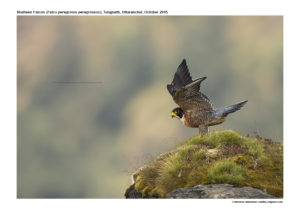Shaheen-falcon

Shaheen Falcon ( Sub Species of Peregrine Falcon) Falco peregrinus peregrinator
Etymology:
- Falco : Latin for Falcon based on Sickle shaped claws ( falcis- sickle)
- Peregrinus : Latin word peregrinus- wanderer
- Peregrinator : Latin Word for “Wanderer”
Vernacular Names: Hindi: (F) Bhyri, Shaaheen kohi, (M) Bhyri bacha, Kohila, Shaheen, Safed shaheen, Pun: Lalsir shaheen, Bahiri, Shahin, Guj: Shaaheen, Kalo shaaheen, Lal mathani shahin, (F) Bheri, Shahin, (M) Bheribacho, Shahincha , Mar: Shaahin sassana/ Bahiri Sasana, Ori: Chhanchana, Ta: Valluru, Te: Bhyri dega, Yerkali: Dega, Mal: Kayal pullu, Karimpullu, Sinh: Kurulla goya
Distribution in India: Wide spread Resident and Winter Visitor.
Sub-Species of Peregrine falcon
Description: Size of 38-51 cm. It is a small and powerful-looking falcon with blackish upperparts, rufous underparts with fine, dark streaks, and white on the throat. The complete black face mask is sharply demarcated from the white throat. It has distinctive rufous underwing-coverts. There is no visible sexual dimorphism except that the female is larger and heavier than the male.
Habitat: It is found on rocky and hilly regions on cliffs and rock pinnacles.
Food Habits: It eats chiefly birds; occasionally mammals, including bats, rats, rabbits and voles; also insects, reptiles and exceptionally fish. Birds taken mainly in flight: when searching for prey, often flies high or perches at prominent site; once it locates prey, it typically pursues it at great speed, frequently culminating in very rapid stoop. Prey is typically struck and captured in mid-air; it strikes its prey with a clenched foot, stunning or killing it with the impact, then turns to catch it in mid-air. If its prey is too heavy to carry, it will drop it to the ground and eat it there. If they miss the initial strike, peregrines will chase their prey in a twisting flight. Sometimes prey is taken on ground or water. Many other techniques recorded, including hawking for insects, hovering and quartering. Hunts most often at dawn and dusk, when prey are most active, but also nocturnally in cities, particularly during migration periods when hunting at night may become prevalent.
Breeding Habits: They breed in Dec-April in India. The courtship flight includes a mix of aerial acrobatics, precise spirals, and steep dives. The male passes prey it has caught to the female in mid-air. To make this possible, the female actually flies upside-down to receive the food from the male’s talons. No nest is built. The eggs are laid in scrape or depression on cliff, in disused stick nest of another species or in a tree hollow or on ground or below the ground in a sink hole. It lays a clutch of 3-4 eggs. The incubation period is 29–32 days. The replacement of lost clutch may occur within 2 weeks. The chicks are born altricial, adult male provides most of food during first half of nestling period. The fledging period is 35–42 days. The chicks remain dependent on parents for 2 months.
.